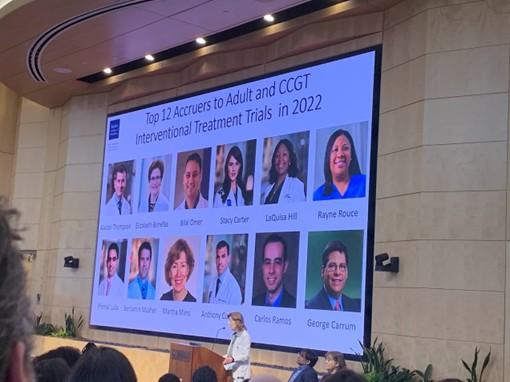
Clinical Trials for cancer are research studies that test the safety and effectiveness of new treatments or medical products, like medicines and devices, in healthy volunteers or patients. These studies may show which medical approaches work best for certain malignancies or patient populations. Certain demographic groups are less frequently enrolled in clinical research, posing a challenge for outcome interpretation as people of different ages, races, and ethnicities may respond differently to different cancer interventions.
Local Cancer Burden: Key Insights
In our catchment area, the four most common cancers mirror national trends: breast (17%), prostate (15%), lung and bronchus (12%), and colorectal (10%). While Black women have a lower overall rate of breast cancer compared to White women, they are twice as likely to be diagnosed with triple-negative breast cancer, a more aggressive subtype. Additionally, Black individuals experience higher incidence and mortality rates for both prostate and colorectal cancers.
Liver cancer rates in our area are higher than the national average (10 vs. 8 per 100,000 people), with even higher rates among Black and Hispanic communities. In our catchment area, cervical cancer is also more common and more deadly, with about 20% more cases and 30% higher mortality compared to the U.S. overall.
Compared to the rest of the country, fewer children are diagnosed with cancer in our area. However, childhood cancer mortality is about 23% higher. This increase in mortality is likely due to the higher proportion of Hispanic children in the region, who often experience worse outcomes in certain cancers, like leukemia.
Therefore, it is important to include all patients in our catchment area in cancer research. As we study new and better ways to treat cancer, we must ensure that everyone who could benefit has the chance to take part in clinical trials, access investigational therapies, and be included in efforts to understand treatment outcomes.
Expanding Access to Clinical Trials through Community Collaboration
The DLDCCC COE is dedicated to enhancing clinical trial support across communities within and beyond our catchment area, acknowledging the many barriers that have hindered research participation for different groups. Some of these barriers include a lack of awareness, medical mistrust, and logistical or financial challenges, which contribute to different rates of healthcare uptake and clinical trial enrollment.
To address these common concerns, the COE uses a multi-level, multi-step approach that involves ongoing communication among staff from the COE and the Office of Outreach and Health Disparities (OOHD), the Community and Patient Advisory Board (CAB/PCAB), local community groups, and DLDCCC members. Through these interactions, the CAB/PCAB communicate outreach-related priorities directly to COE and DLDCCC leadership (Figure 1). COE conducts quarterly needs assessments with the CAB/PCAB, community partners, and community members at outreach events to better understand community cancer education and research priorities, identify key needs, and ensure the DLDCCC strategic goals align with community needs.
Key priorities identified for 2024-2025 include:
- Increase community awareness of lifestyle, genetics, and environmental cancer risk factors.
- Increase cancer prevention, screening, and uptake for breast, CRC, liver, and HPV-associated cancers.
- Provide education on biological determinants of cancer disparities.
- Develop, test, and disseminate interventions to increase physical activity and reduce child obesity.
- Increase participation in clinical trials through community education.
COE Facilitated Bidirectional Engagement Examples:
- Community members identified the need for culturally and linguistically tailored educational materials about cell therapy clinical trials. Program leadership noted challenges in simplifying the complex information and addressing common concerns. In response, CAB/PCAB in coordination with COE, led the development of culturally and linguistically appropriate trial materials. In addition, they also provided training for providers on best practices for enrolling and retaining diverse populations, using CRTEC lay-language.
- Community members reported limited health literacy and difficulty navigating clinical trials logistics and insurance barriers. Program data showed lower trial enrollment among uninsured, publicly insured, and out-of-network patients. In response, COE in collaboration with CPPS and the CAB/PCAB, launched a community-based clinical trial insurance navigation and health literacy program. They also developed an educational curriculum to train Community Cancer Research Ambassadors.
COE efforts to boost clinical trial recruitment and retention presentation:
- Review study materials – Ensure that study protocols and informed consent forms are easy to understand, address common misconceptions and concerns, and are reflective of the feedback from the CAB/PCAB and community members, culturally.
- Offer Proposal and Protocol Feedback – Participate in the DLDCCC’s Protocol Review and Monitoring Committee (PRMC) meetings to provide feedback on how proposals align with catchment area priorities.
- Lead Healthcare Provider Training – Collaborate with our CAB/PCAB to offer interactive training workshops for DLDCCC members, clinical researchers, and clinical trials that train on best practices for recruitment, retention, and engagement with broad patient populations and community partners.
- Address Barriers – Provide clinical trial and clinical research consultations, working with investigators and study teams to identify and troubleshoot study-specific barriers.
In coordination with our Theater Outreach Program, we have produced two videos that cover common misconceptions about clinical trials and research participation, which we showcase both within DLDCCC and in the broader community.
A Win-Win for Everyone - a short reel about the importance of participating in clinical trials in the African American community (English ~6 minutes).
Todos Ganamos - a short reel about the importance of participating in clinical trials in the Hispanic Community (Spanish with English subtitles ~6 minutes).
COE has also developed a number of educational videos on the importance of representation in clinical trials. These videos can be viewed on our Online Health Library under the Monologues – Quick Reels tab.
Learn more about clinical trial opportunities at Baylor College of Medicine.








